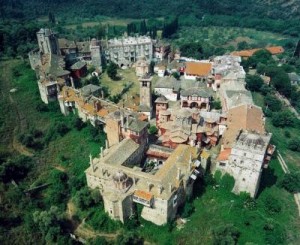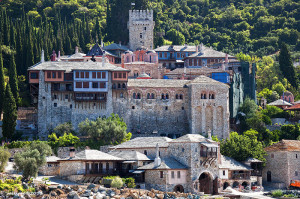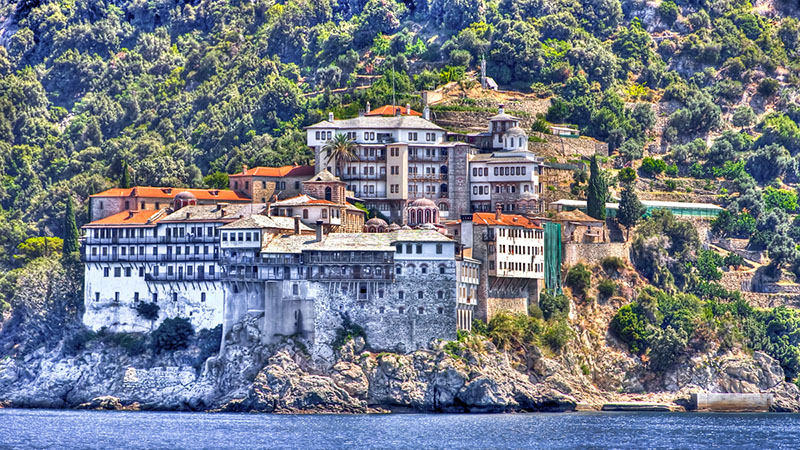Agios Oros, the holy mountain of the Orthodox world, is a place of peace and reflection, geared totally to a monastic way of life. In actual fact, it is ruled over by a woman, even though it is now only accessible to men. The Holy Mother of God is supposed to have interrupted her journey to rest here. Since then, the Holy Mount Athos has been known as the “Garden of the Virgin Mary”.
The wild, rocky finger of land is dominated by the majestic summit of the 6690′ (2039m) high Mount Athos. It is usually wreathed in cloud, intensifying the mystical atmosphere of the Athos monasteries, some of which are 1000 years old. This autonomous monastic state is the oldest religious community still in existence in the world and therefore an important centre for all Orthodox Christians.
It is believed that the first monks arrived here in the 7th century, although Mount Athos does not officially figure in history as a monastic community until the 10th century, when two monks named Athanasios the Athonite and Pávlos Xeropotaminos built the first monastery here in A.D. 963. The 12th century brought other nationalities of Orthodox monks, such as Georgians, Serbs, and Russians.
The monks of Athos cultivate everything they need to survive themselves. However, most of the peninsula is wild and uncultivated and home to herbs and plants, that have long since died out elsewhere. It is no coincidence that the only village and so-called ‘capital’ of Athos is called Karyés after the hazelnut bushes that grow in such profusion along the donkey trails and paths linking the monasteries.
The unusual diversity of flora (over 1000 different species) is due the favorable climatic conditions as well as the absence of any large animals. Only small animals survive in the impenetrable thickets near the mountain summit. Butterflies and birds provide the finishing touch to this earthly paradise.
In the heyday of this monastic republic, the main monasteries could each accommodate several thousand monks, but they are now inhabited by just a couple of dozen brothers. In addition, there are other smaller monastic communities including skítes, small monastic settlements, small farms called kéllia, often home to two or even just one monk, and lastly remote hermits’ retreats, erimitíria. The larger monasteries have valuable libraries and collections of icons, which are documented inter alia in the renowned Painter’s Manual of Mount Athos. The churches are full of sumptuous paintings and the architecture of the monasteries of Mount Athos, some of which have fortified walls facing the sea, is an amazing sight. Athos is a real cultural treasure and is receiving financial support from UNESCO to prevent is falling into further decline.
The last town before you enter the monastic republic is called Ouranópolis. There are more monks in Ouranópolis than anywhere else in the world, and this is no coincidence for the name of the town means “Heavenly City”, and represents the last bastion of all that is worldly. About 500m south of the town is a wall topped with barbed wire, behind which lies the Holy Mount Athos, the autonomous monastic republic. Every day, boats ply in and out of Daphne, the harbor of Ouranópolis, providing the only link between Daphne and the rest of the world.
Ouranópolis only came into being in the 1920s. Up until then, the old tower on the breakwater was a symbol of the monastic state, visible only from the sea.It was used as a watchtower to guard against strangers or robbers entering the Athos area unseen. It was not until 1922, when large numbers of Greeks fled from Asia Minor, that the monks finally acceded to requests by the Greek government and released the land to accommodate refugees. This changed the borders of Athos and gave rise to an 800-strong community, which now not only represents the extremity of the secular world, but is also a reminder of times of great social change. The people felt a debt of gratitude to the monks. Many of them were able to continue their trade as fisherman in the town as the waters around Athos were and remain some of the richest fishing areas in Greece.
Two of the monasteries are:
Xenofóndos – first mentioned in 1033 and dedicated to St. Georgios. It has a world-famous library.
Panteleímon – founded in 1765 near the site of an earlier monastery of the same name. It has a basilica situated in the inner courtyard.
This really is an extraordinary island
and if there is anywhere in the world where time has stood still, then surely this must be the place.













